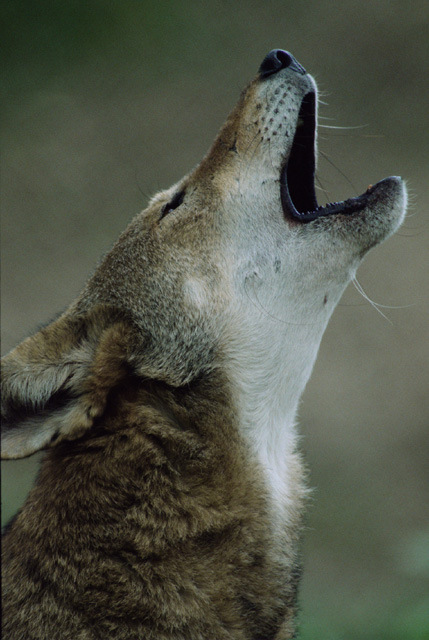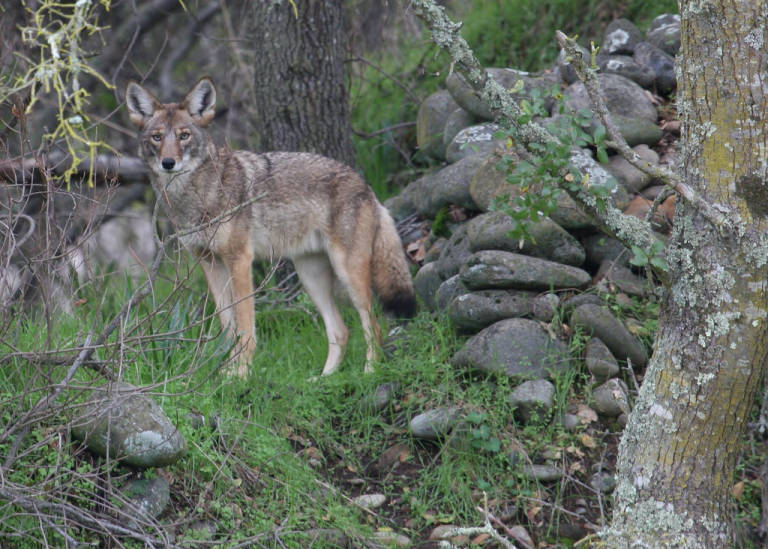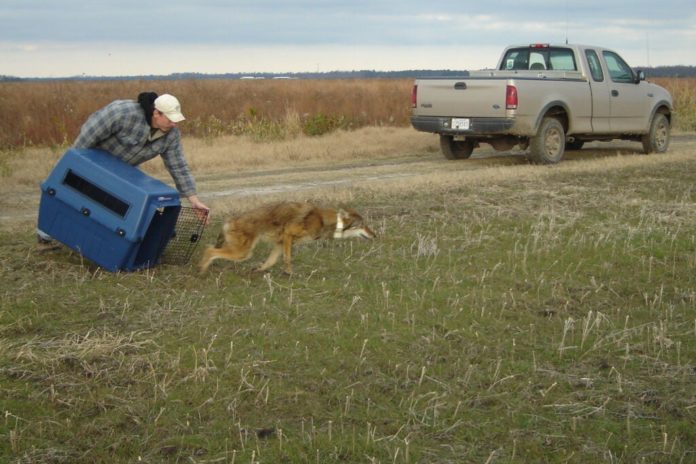Reintroduced red wolf packs in the Southeast could lead to better deer hunting, and more coveys of quail—at least, that’s what one group of researchers hopes to prove.
Ron Sutherland, a wildlife biologist born and raised in North Carolina, spends most of his life talking about and advocating for red wolves. His motive is obvious: to see red wolves sustainably managed in a slice of their original home range. He wants red wolves reintroduced largely because they are a natural part of the ecosystem, but also because, he says, research is starting to show they can actually benefit the area’s native species.
Why? In large part because red wolves require larger home ranges than coyotes, and enough wolves will push nonnative coyotes to the fringes. Also, red wolves commonly prey upon mid-sized predators like raccoons and opossums.
Sutherland, unsurprisingly, has his fair share of skeptics. And venom toward red wolves is bubbling up anew after a federal judge recently ordered biologists to open pens and release captive-born red wolves back on the landscape in two wildlife refuges in North Carolina.
Ten red wolves will join another eight or so genetically pure collared red wolves who already live there, bringing the sum total of red wolves living in the wild to between 20 and 25, depending on how recently one has been shot or hit by a car and if estimates of wolves without collars are accurate. Red wolves are the most endangered wolf in the world and they’re at real risk of extinction in the wild. Again.
This time biologists and wildlife managers hope the long-term result of the reintroduction effort will be different. The U.S. Fish and Wildlife Service assembled a massive recovery team made of state, federal, county and tribal representatives as well as biologists, researchers, landowners, locals, and nonprofits. A federal program created a cost share for local landowners interested in improving habitat for wildlife on their land—aptly named Prey for the Pack. But still, there’s plenty of contention around the impact that red wolves have on local wildlife.
Can Red Wolves Help Native Wildlife?
Since 2015, Sutherland and a team at Wildlands Network, a small conservation nonprofit, have been recording hundreds of thousands of images from trail cameras to see how much wildlife exists in areas where red wolves roam.
He’s still sifting through all of the information, but what he can say is that “we’re seeing deer at all the sites where we see wolves.”
At a minimum, researchers say, more red wolves likely won’t hurt deer populations. For proof, they say look no further than historical patterns when red wolves numbered around 120 and deer populations were at their highest peaks in the last 50 years.

In 1976, hunters killed 2,263 whitetail deer in the five counties where red wolves were eventually reintroduced. In 2012, at the height of the red wolf population, hunters killed 7,491 deer in those same counties, a 231 percent increase. By 2020, that number seemed to mirror the decline in wolf numbers, dropping 31 percent to 5,174 deer. In short, as wolf numbers increased from the late ‘80s until the late 2000s, so did whitetail deer populations. Then as wolf numbers decreased, so did whitetail deer. You won’t see wildlife managers drawing a direct line of causation between the historical rise in wolf numbers and the rise in deer numbers, but on the other hand, it’s hard to argue against the correlation.
“They say [red wolves are] a detriment to the deer population, but show me where that is happening,” Art Beyer, a former red wolf biologist with the Fish and Wildlife Service told the Virginia Pilot in 2014. “I don’t see that happening. This is where you’ve got farmers shooting deer in their fields because they’re eating their crops.”
Joseph Hinton, a senior research scientist with the Wolf Conservation Center who has studied red wolves and coyotes for over 20 years, points to the fact that red wolves have a much larger home range than coyotes, and when red wolves pair up, they will kick coyotes out of the area.
“If you eliminate a wolf pack, that opens up the territory. How many coyote packs can fit in there? We usually see two to three,” Hinton says. “A coyote home range size is 20 to 25 square kilometers and a red wolf is about 70 square kilometers and some will have 140 square kilometers. If you wipe out a wolf pack, more coyote packs will take up that space.”
Established red wolves theoretically means fewer coyotes, which means an overall fewer number of predators targeting game species.
Plus, there are plenty of deer to go around, says Joe Landino, a landowner and hunter in Hyde County. Landino moved to the area 60 years ago to manage 300,000 acres of land for a pulp and paper company. Over the years he’s managed forests and farms and spent most of his life outside. He doesn’t have issues with red wolves.
“We have more deer now than before the red wolf showed up. I have landowner friends of mine saying red wolves have devastated the deer population. That’s a bunch of baloney. You can shoot five deer here legally and the season runs October 15 to January 31. Basically, you can kill all the deer you want,” Landino says. “When I came here 60 years ago, a deer that weighed 100 pounds was as a big as you’d see, but since we developed farmland, we have pretty nice deer and lots of them.”
Sutherland also has cameras at one of the rare sites where bobwhite quail are surviving. That area also happens to fall within the Alligator National Wildlife Refuge, where red wolves have been stable the longest.
During surveys, “the numbers of calling quail roosters were off the charts,” Sutherland says. “More were calling at once than we could write down.”
The reason quail thrive there, he says, is because red wolves either scare away or kill quail nest predators like raccoons and opossums.
Landowner Skepticism
Even though Landino doesn’t mind red wolves, he also doesn’t think wild red wolves will survive long term. It’s just not red wolf country anymore, he says.
Jennifer Skvarla, a landowner in Beauford County, says she used to see red wolves on her land, and they never caused her issues. She now hears the coyotes constantly, and wonders if red wolves can return, and if they may help displace the number of coyotes in the area.
Greg Comstock, on the other hand, says red wolves have no place in the region and offer no benefit to people or wildlife. He runs a bear hunting club in Hyde County.
“Red wolves are the last thing we need in this area,” he says. “The coyotes are taking over now and we can’t hunt coyotes because if you shoot the wrong thing you’re in trouble.”
He believes far more red wolves and red wolf hybrids live on the landscape than the Fish and Wildlife Service admits. He also worries the deer hunting is suffering. He says that he and other hunters and landowners don’t have enough information from the Fish and Wildlife Service.

And there’s no doubt that red wolves will eat deer, but predator-prey dynamics are infinitely complicated. For example, there are a variety of studies about the impacts that predators have on whitetails in the Southeast—and many of them seem to conflict. A 2012 radio collar study published in the Journal of Wildlife Management found that coyotes were likely responsible for 80 percent of fawn mortalities within the South Carolina study group. A 2016 University of Georgia research paper that examines deer predation in the southeast states that: “It is unlikely that predators limit population growth of highly productive deer herds with relatively low natural mortality. Unfortunately, in some studies, 70 to 100 percent of fawns died each year of natural causes including predation. In these situations, predation likely is limiting population growth and reducing the percentage of the herd available for hunting.”
But then there’s the 2019 study, also published in the Journal of Wildlife Management, which found that eastern coyote colonization actually didn’t have negative impacts on regional deer populations in any regions of the East.
“Coyotes moved in as the new top predator of the East, but they aren’t nearly as effective deer hunters as wolves, so there’s been a lot of controversy about whether these medium-sized predators can really limit deer populations at large scales,” Roland Kays, a wildlife biologist and co-author of the study told NaturalSciences.org when the paper was published.
For a landowner like Comstock, the math around wolves and coyotes is much simpler: more predators equal more problems.
“I don’t think there’s a place for [red wolves] here,” Comstock says.
A History of Red Wolves … and Coyotes
Red wolves were declared extinct in the wild in 1980. They’re the only wolf native exclusively to the U.S., originally ranging from Pennsylvania and New Jersey down to Florida and south Texas. A coordinated campaign in the late 1800s and early 1900s resulted in the near-eradication of the 45-80 pound wolf. By 1972, only a small number remained in isolated pockets of southeast Texas and southwest Louisiana, according to the U.S. Fish and Wildlife Service.
Federal officials placed the red wolf on the endangered species list in 1967, and between 1973 and 1980 rounded up the remaining red wolves they could find, winnowed them down to select for pure genetics, placed the remaining 14 in zoos and captive breeding facilities, and declared the species extinct in the wild.
And there the red wolves stayed, in dozens of facilities across the country, where their numbers climbed to the 200s. The Fish and Wildlife Service began releasing them in 1987 on the Alligator River National Wildlife Refuge in eastern North Carolina as part of a “nonessential experimental population,” which means the rules for accidental death of an endangered species are a little less stringent.

The reintroduction efforts seemed to work. A female birthed the first litter of pups in the wild in 1988, and by 2012, wildlife managers estimated about 120 red wolves lived across hundreds of thousands of acres in portions of five counties. But like all programs to reintroduce controversial species to a landscape, it got complicated.
Many of the issues center less around red wolves than coyotes.
Eastern coyotes, which are generally a bit bigger than their western counterparts at around 20-35 pounds, originally lived north of red wolf range in Canada. But in the absence of red wolves, they began making their way south and east, Hinton says.
“You had core populations of red wolves and eastern wolves, and once those were knocked out, it opened up the area to [coyote] colonizing,” Hinton says.
When red wolves were reintroduced, the presence of coyotes meant landowners in the area were dealing with two kinds of predators that looked, at least from a distance, pretty similar. As red wolf numbers increased, so did accidental shootings. But likely so did intentional shootings that were played off as cases of mistaken identity.
“Gunshot mortality is the leading cause of death for red wolves,” says Joe Madison, Red Wolf Recovery Program Manager for the Fish and Wildlife Service. “The second leading cause is vehicle strikes. When you factor in other smaller issues like poisoning, human caused mortality has a pretty substantial impact on the red wolf population. A red wolf in the wild that dies of natural causes averages around 9 years old. When you factor in human caused mortality, it’s around 4 years old.”
Environmental groups filed lawsuits, the state pushed back, and eventually reached a settlement in the five counties that stopped a short-lived nighttime coyote hunting season to prevent accidental red wolf deaths. The settlement also allowed coyote hunting on private land in those five counties with a permit, but prohibited it with narrow exceptions on public land.
These new regulations did not sit well with many landowners. Some said the Fish and Wildlife Service was dictating how they operate their own private land. Others said red wolves and coyotes were decimating wild game populations. Many said pure red wolves didn’t exist—that they were all a coyote-wolf hybrid. As uproar over red wolves increased, their numbers decreased.
That also meant red wolves that couldn’t find a suitable mate began to hybridize with coyotes, Hinton says.
“Red wolves don’t tolerate coyotes unless they have to,” Hinton says. “If a solitary male can’t find a mate, it will breed with a coyote, but if there are other red wolves around, they will preferentially partner with red wolves.”
Since 2000, the Fish and Wildlife Service had been working to prevent hybridization by capturing male and female coyotes, sterilizing them, and releasing them back on the landscape. This strategy has also been criticized by hunters and landowners.
Then in 2015, locals had had enough. The North Carolina Wildlife Resources Commission passed two resolutions, one asking the Fish and Wildlife Service to end the experimental reintroduction project and the other requesting the Service to round up the remaining red wolves.
“The Wildlife Commission cited 64 unauthorized releases of red wolves on private lands in what the U.S. Fish and Wildlife Service had intended to be done on federal public land as one of the reasons to recapture the red wolves and offspring that were unauthorized releases,” reads the Commission’s resolution.
The Fish and Wildlife Service announced in 2018 that it would create a new experimental rule for managing red wolves that would dramatically shrink the active recovery area and largely stopped reintroducing the species into the wild.
Then in 2019, the National Academy of Sciences declared red wolves its own distinct species, and in 2021 a federal judge ordered that the Service create a plan to release more wolves.
Is Red Wolf Recovery Realistic?
So, can a species with fewer than 20 individuals in the wild overcome the possibility of hybridization and the societal headwinds to even partially recover?
Sutherland says yes. And so does Madison, the Fish and Wildlife Service program manager in North Carolina.

“I’m not an optimist by nature, and this is not an easy task, but I believe it’s possible and possible in North Carolina,” Madison says. “You can feel the tide turning… We have a lot of support from a lot of folks, and it’s hard to not be at least a little optimistic about it.”
The Fish and Wildlife Service also touts a new program called Prey for the Pack, which pays private landowners to make habitat improvements.
“Joining the Prey for the Pack program has been the best single decision I’ve made since buying my hunting property,” says landowner Nick Glasgow in a news release about the program. “Habitat improvements have not only strengthened an endangered species’ chance of survival but increased the deer and bear numbers using my property.”
Sutherland hopes to have his research finalized and ready for publication by the end of the summer. His goal is to use science to show red wolves’ positive impact on wildlife. At the same time, Fish and Wildlife Service officials will continue working with a team of dozens of locals to come up with a plan for the animals’ future.
“We’re trying to be more open with the community about red wolves and where they are and what we’re doing,” Madison says. “The road is long. There’s eight known individuals, but there’s some good energy getting put into it now.”


